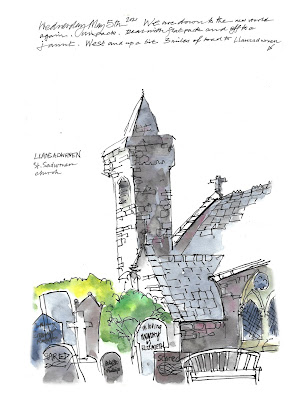30th May
THE LAND OF IMPOSSIBLE GREENS
Our town, Laugharne squats at the end of an estuary. Here the Afon Taf flows into Carmarthen Bay and eventually the Bristol Channel. On the other side of this estuary are deserted churches, small farm fields and narrow roads draped in flowers. Cow Parsley, Red campion, butter cups, blue bells and hawthorn compete for room to flourish. Hedges are high. In the shade hearts tongue ferns glow in a green haze.
We drive down roads are like some helter-skelter rising up to the sun and plunging down to shady bridges and crumbling cottages. Up, up again, to a field of views across a hundred fields. A line of pylons march across this land.
We enjoy so much green, from darkest viridian to almost lemon. We pass gates are held together by rust and blue bailer twine. Red rust and turquoise blue the compliment to green on the colour wheel.
 |
| Llansteffan Beach: Mum! I've found a jelly Fish |
As we make our way to Llansteffan* the land seems to pant in the high sun. We meet villages along the way. Llan-this, Llan-that. ‘Llan’ means Christian settlement, often a church, conjoined with a local saint. *Llansteffan - St Stephen. Often these saints were from ruling families who invaded Wales in the Middle Ages. There are 630 Llans’ in Wales.
Llan y bri, through which we pass has two chapels, Capel Newydd, new chapel, is home now to most of Dylan Thomas’ maternal relatives. In the village there is Hen Gapel, was the only medieval church in Wales to be converted to a non-conformist chapel. Now it is out of service and without a roof; God has an interrupted view on the congregation.
 |
| Hen Gapel: No roof, God has an interrupted view on the congregation. |
There is a high concentrate of history, round every bend in the road.





















